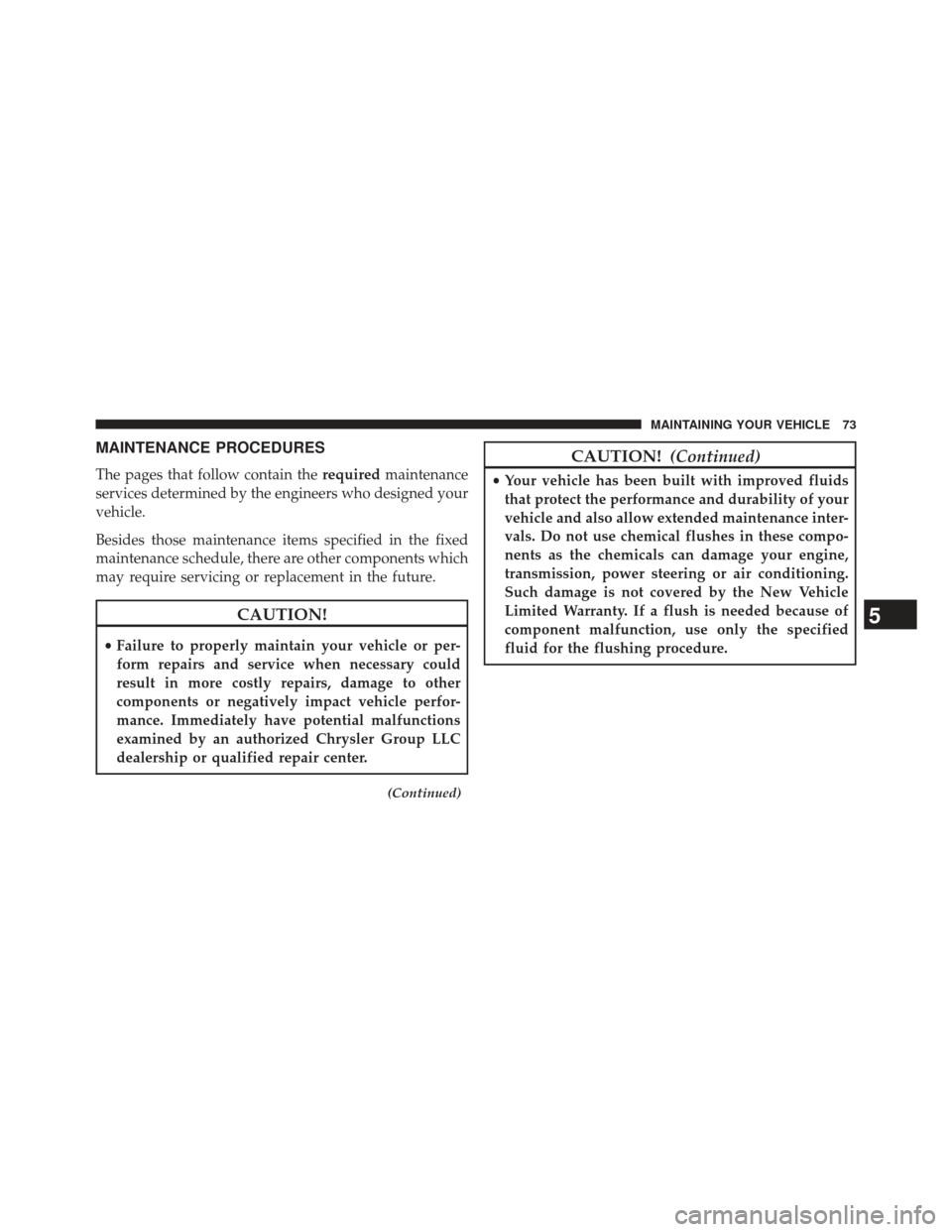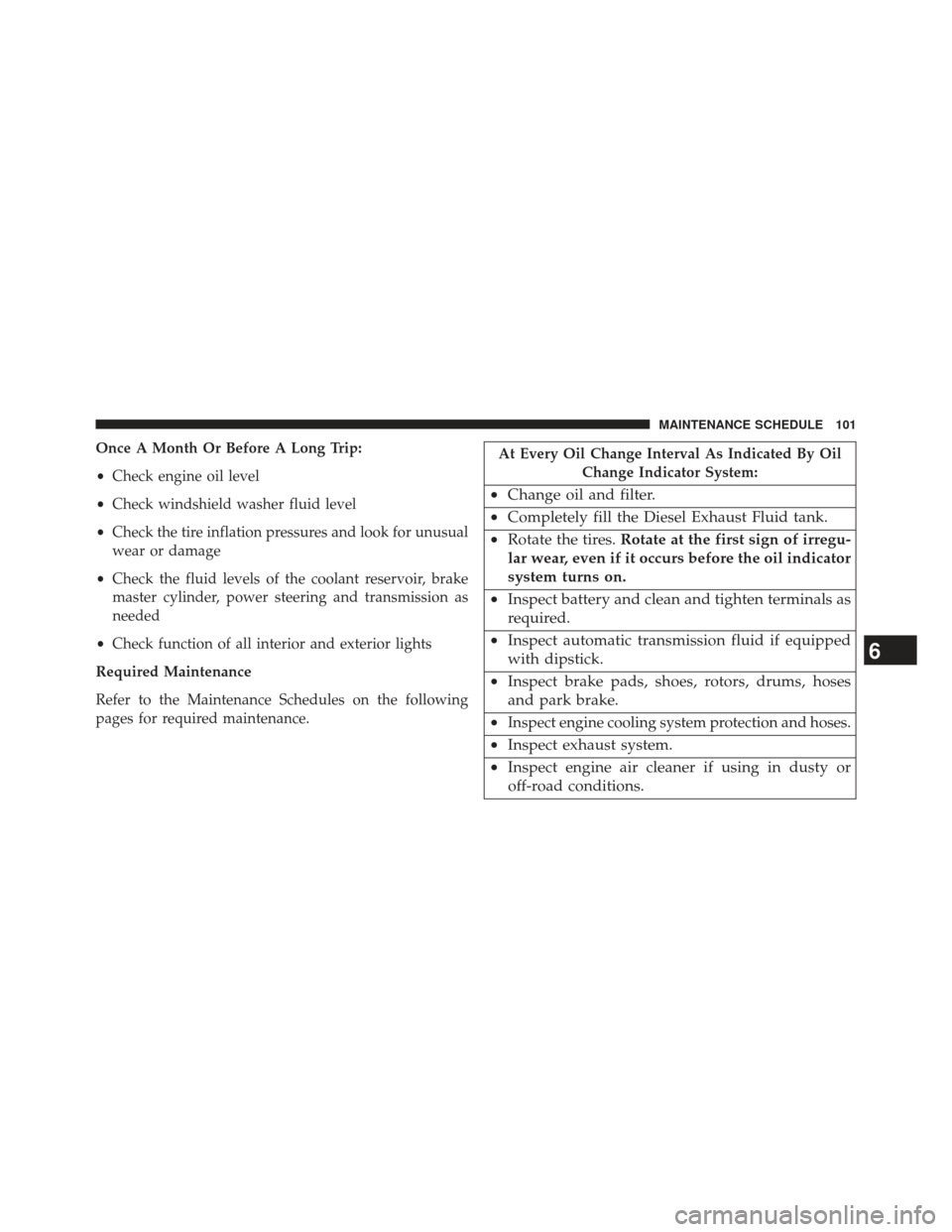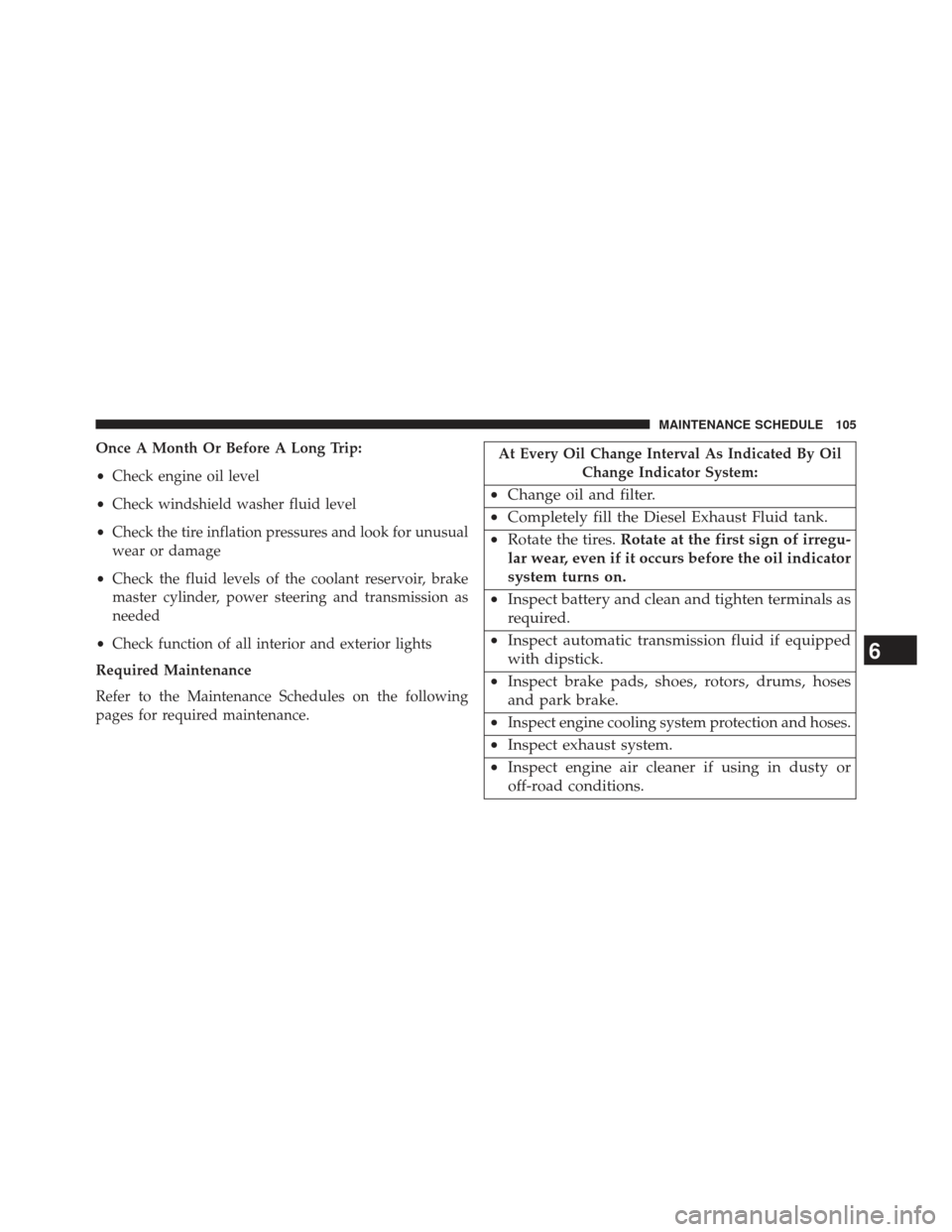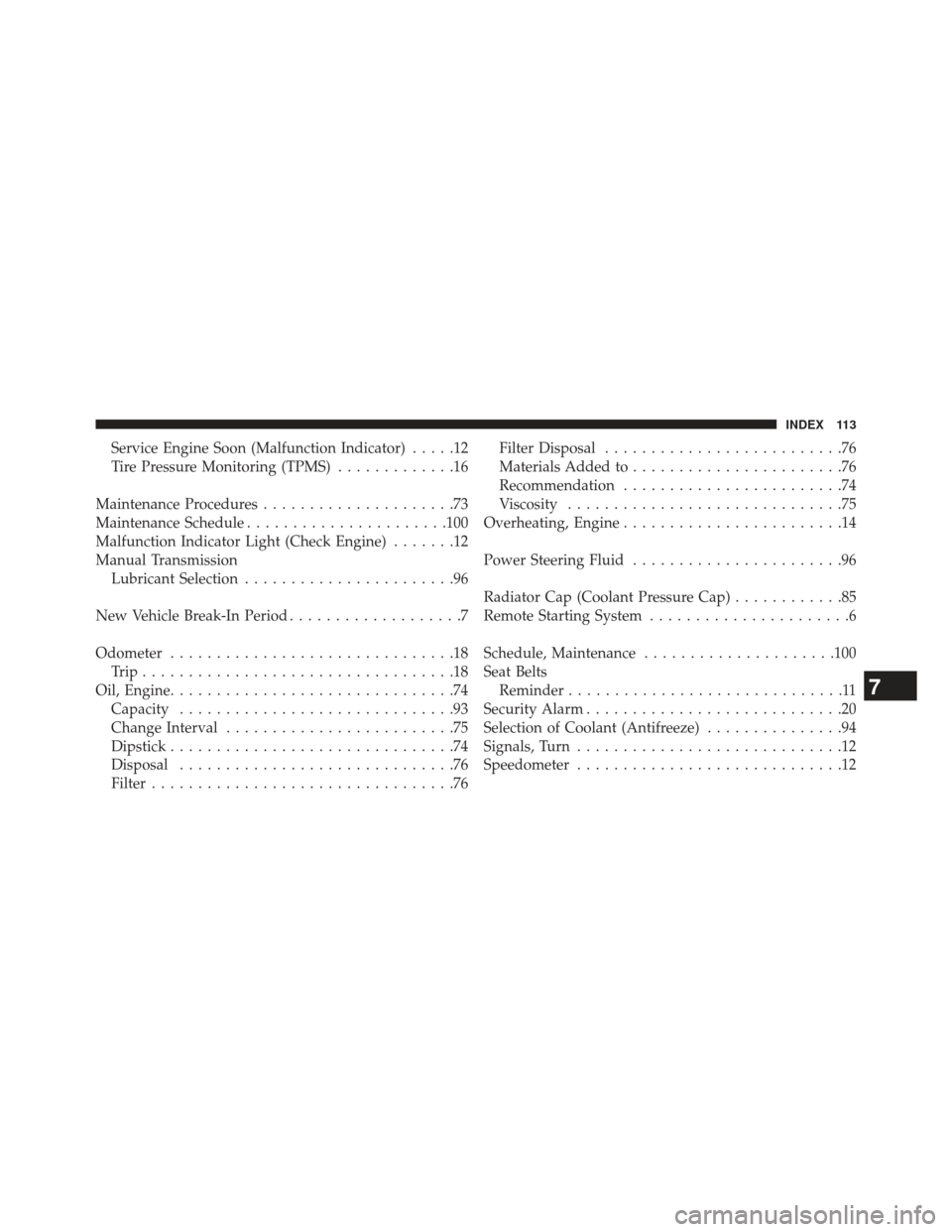Page 74 of 118
ENGINE COMPARTMENT — 3.0L DIESEL
1 — Remote Jump Start Location6 — Air Cleaner Filter
2 — Power Distribution Center (Fuses) 7 — Washer Fluid Reservoir
3 — Engine Coolant Reservoir 8 — Engine Oil Fill
4 — Integrated Power Module (Fuses) 9 — Engine Oil Dipstick
5 — Power Steering Fluid Reservoir 72 MAINTAINING YOUR VEHICLE
Page 75 of 118

MAINTENANCE PROCEDURES
The pages that follow contain therequiredmaintenance
services determined by the engineers who designed your
vehicle.
Besides those maintenance items specified in the fixed
maintenance schedule, there are other components which
may require servicing or replacement in the future.
CAUTION!
• Failure to properly maintain your vehicle or per-
form repairs and service when necessary could
result in more costly repairs, damage to other
components or negatively impact vehicle perfor-
mance. Immediately have potential malfunctions
examined by an authorized Chrysler Group LLC
dealership or qualified repair center.
(Continued)
CAUTION! (Continued)
•Your vehicle has been built with improved fluids
that protect the performance and durability of your
vehicle and also allow extended maintenance inter-
vals. Do not use chemical flushes in these compo-
nents as the chemicals can damage your engine,
transmission, power steering or air conditioning.
Such damage is not covered by the New Vehicle
Limited Warranty. If a flush is needed because of
component malfunction, use only the specified
fluid for the flushing procedure.
5
MAINTAINING YOUR VEHICLE 73
Page 99 of 118
ComponentFluid, Lubricant, or Genuine Part
Axle Differential (Rear) – With Electronic Limited-Slip
Differential (ELSD) We recommend you use MOPAR® GL-5 Synthetic Axle
Lubricant SAE 75W-85 with friction modifier additive.
Axle Differential (Rear) – Without Electronic Limited-
Slip Differential (ELSD) We recommend you use MOPAR® GL-5 Synthetic Axle
Lubricant SAE 75W-85.
Brake Master Cylinder We recommend you use MOPAR® DOT 3 Brake Fluid,
SAE J1703 should be used. If DOT 3, SAE J1703 brake
fluid is not available, then DOT 4 is acceptable.
Power Steering Reservoir – 3.0L Engine We recommend you use MOPAR® Hydraulic fluid
MS-11655.
5
MAINTAINING YOUR VEHICLE 97
Page 103 of 118

Once A Month Or Before A Long Trip:
•Check engine oil level
• Check windshield washer fluid level
• Check the tire inflation pressures and look for unusual
wear or damage
• Check the fluid levels of the coolant reservoir, brake
master cylinder, power steering and transmission as
needed
• Check function of all interior and exterior lights
Required Maintenance
Refer to the Maintenance Schedules on the following
pages for required maintenance.At Every Oil Change Interval As Indicated By Oil Change Indicator System:
•Change oil and filter.
• Completely fill the Diesel Exhaust Fluid tank.
• Rotate the tires. Rotate at the first sign of irregu-
lar wear, even if it occurs before the oil indicator
system turns on.
• Inspect battery and clean and tighten terminals as
required.
• Inspect automatic transmission fluid if equipped
with dipstick.
• Inspect brake pads, shoes, rotors, drums, hoses
and park brake.
•
Inspect engine cooling system protection and hoses.
• Inspect exhaust system.
• Inspect engine air cleaner if using in dusty or
off-road conditions.
6
MAINTENANCE SCHEDULE 101
Page 107 of 118

Once A Month Or Before A Long Trip:
•Check engine oil level
• Check windshield washer fluid level
• Check the tire inflation pressures and look for unusual
wear or damage
• Check the fluid levels of the coolant reservoir, brake
master cylinder, power steering and transmission as
needed
• Check function of all interior and exterior lights
Required Maintenance
Refer to the Maintenance Schedules on the following
pages for required maintenance.At Every Oil Change Interval As Indicated By Oil Change Indicator System:
•Change oil and filter.
• Completely fill the Diesel Exhaust Fluid tank.
• Rotate the tires. Rotate at the first sign of irregu-
lar wear, even if it occurs before the oil indicator
system turns on.
• Inspect battery and clean and tighten terminals as
required.
• Inspect automatic transmission fluid if equipped
with dipstick.
• Inspect brake pads, shoes, rotors, drums, hoses
and park brake.
•
Inspect engine cooling system protection and hoses.
• Inspect exhaust system.
• Inspect engine air cleaner if using in dusty or
off-road conditions.
6
MAINTENANCE SCHEDULE 105
Page 115 of 118

Service Engine Soon (Malfunction Indicator).....12
Tire Pressure Monitoring (TPMS) .............16
Maintenance Procedures .....................73
Maintenance Schedule ..................... .100
Malfunction Indicator Light (Check Engine) .......12
Manual Transmission Lubricant Selection .......................96
New Vehicle Break-In Period ...................7
Odometer ...............................18
Trip..................................18
Oil, Engine ...............................74
Capacity ..............................93
Change Interval .........................75
Dipstick ...............................74
Disposal ..............................76
Filter .................................76 Filter Disposal
..........................76
Materials Added to .......................76
Recommendation ........................74
Viscosity ..............................75
Overheating, Engine ........................14
Power Steering Fluid .......................96
Radiator Cap (Coolant Pressure Cap) ............85
Remote Starting System ......................6
Schedule, Maintenance .....................100
Seat Belts Reminder ..............................11
Security Alarm ............................20
Selection of Coolant (Antifreeze) ...............94
Signals, Turn .............................12
Speedometer .............................12
7
INDEX 113